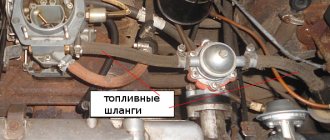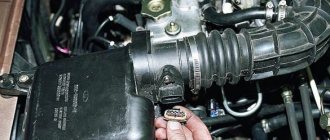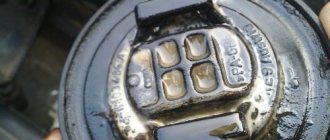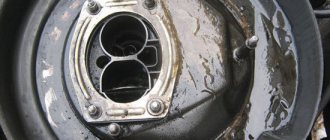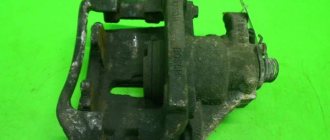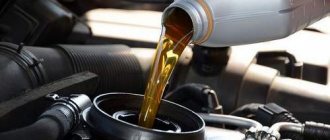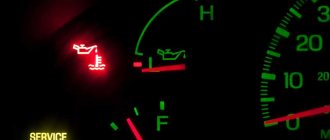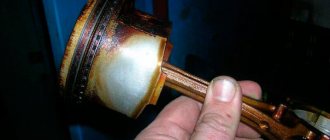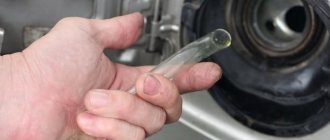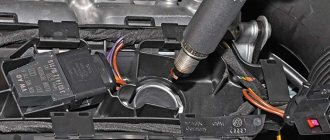When the starter spins when starting the engine, but the car does not start, many motorists begin to look for a problem in the battery. But sometimes it’s not his fault. In winter or autumn, when the air is damp or cold, starting the car in the morning can become a real problem. It turns out that quite often the spark plugs flood when starting the engine. Let's figure out why this happens. And how you can fight these.
Why does the candles flood?
Before you begin active actions, you need to understand at least a little what happens to the spark plugs when you turn the key in the ignition. When the starter begins to move the valves of the engine cylinders, that is, it tries to start the engine, gasoline is mixed with air in the cylinder chamber, after which it is ignited by a spark from a spark plug.
Therefore, we can conclude that without a spark, a micro-explosion will not occur in the combustion chamber of the engine, and it will not start. However, at subzero temperatures (-10 and below) or due to the insufficiently high temperature of the mixture of gasoline and air, chemical reactions do not occur and the mixture does not ignite, as a result of which the spark plugs are filled with fuel and stop working. Now let's figure out what to do if the candles are flooded, when transport is needed right now and there is no time to wait for the master to arrive.
What to do in this case?
Press the accelerator pedal all the way and turn the key in the ignition.
Crank the starter for 8-10 seconds. At the end of this time, the pedal can be returned to its original position.
In most cases, the engine starts.
The peculiarity of this method is that when the gas is fully pressed, the fuel supply to the engine is shut off, and the spark plugs themselves are blown exclusively with air.
If the engine still does not start, then you need to dry the spark plugs.
We fix the problem ourselves
To fix the problem yourself, you need to at least know where the spark plugs are. There are several solutions. The first is installing a new kit, of course, if you have one. It is advisable not to throw away the old ones, but simply put them in the garage. In order to remove the spark plugs, you will need a special spark plug wrench, which almost every motorist has. However, the method is not suitable for everyone, due to the lack of a new kit.
Now let’s look at a method that involves using old candles. The fact is that they are not spoiled, but simply filled with gasoline, but drying alone is also not enough. Therefore, we will need a furnace in which we can heat the candle to a high temperature and change color to red. This event is carried out in order to get rid of residual fuel and the carbon deposits that have actually formed. But here you need to remember that in this case, firstly, the ceramics of the candle will deteriorate, and secondly, polishing will be required before installation.
What to do if the candles are flooded, or Another solution
This method is used by almost all motorists, due to the high efficiency and simplicity of the method. To do this, we will not need to leave the car, because we will carry out the so-called blowing of the spark plugs. We completely squeeze out the accelerometer (gas) part, while turning the starter, at this time a large amount of air will flow to the cylinders and spark plugs, which is drying. During all this, the throttle valve must be fully open.
It should be noted that this method is applicable to both injection and carburetor engines. The only thing you need to be wary of is that your battery will not withstand such loads - it will die before the spark plugs dry. Again, due to the fact that the throttle valve is open to the maximum, gasoline does not flow to the combustion chambers, which is what we need. Now you know what to do if the spark plugs are flooded, but you need to consider the sequence of actions on fuel-injected cars as a separate item.
Flooding when there is a spark and the starter is rotating
Experienced motorists are faced with situations when a spark appears, the starter rotates, but the lower part of the spark plugs is filled with gasoline. Do not be deluded by the presence of a fire, since this event can occur irregularly under pressure and can be lost while the engine is running.
The cause of the event appears to be excessive pressure in the cylinders. It will be possible to identify the event and the factors that motivate it by monitoring the car on a stand that simulates a combustion chamber.
We recommend paying attention to the valve timing, because their failure will be the cause of wet electrodes . In injection internal combustion engines, motorists should check the functionality of the bypass valve located on the fuel rail. If its malfunctions are ruled out, you will need to find out the gasoline pressure in the rail, because the manufacturer regulates this parameter. Sharp fluctuations and going beyond the specified interval (larger/smaller sides) can block the start of the internal combustion engine or stimulate flooding of contacts for spark ignition.
Diagnostics will need to be carried out for the sensors of the electronic control system and for the injectors. An example of a failure is when the coolant temperature sensor sends incorrect data. In such a situation, the control unit unreasonably over-enriches the fuel mixture. Much less often, the culprit of incorrect impulses is a failed electronic control unit or a malfunction of its software. In this case, problems will appear not only with the ignition.
Problem with spark plugs on injector
You probably know that new cars do not have this problem. This is due to sufficient compression. Of course, the quality of the fuel also plays a role: unfortunately, it is not first-class, it is often diluted, which interferes with the normal ignition of the mixture in the cylinders. Also, dirty injection nozzles prevent normal cold starting.
In principle, the situation is resolved quite quickly. To do this, remove the spark plugs, dry them, put them back, check the gaps and start the engine. Since injection spark plugs are practically no different from carburetor spark plugs, the process of cleaning them is exactly the same. They can be unscrewed and then cleaned with a wire brush; in this case, heating is not required. But sometimes the carbon deposits are so strong that you can’t do without it. As a rule, a fully charged battery and a fully working starter will allow you to start the engine without any problems.
Possible causes of fuel overflow
Too high a proportion of fuel in the oil leads to a thinning of the oil film, which, in turn, significantly impairs its performance and, accordingly, increases the degree of wear of engine components. This problem may have the following reasons:
- The injection system is incorrectly configured.
- The mixture enrichment system supplies too rich a mixture during a cold start.
- The injection nozzles do not work properly, for example, due to a clogged fuel filter.
- Due to the gap being too small, the piston hits the cylinder head, thereby causing uncontrolled injection of the injectors.
- Compression pressure is too low. This phenomenon may have the following reasons: The valve is leaking.
- The cylinder head gasket is leaking.
- The valve timing is not set correctly.
- The gap between the piston crown at top dead center and the cylinder head is too large
- One piston ring or several piston rings are defective.
- An error has occurred in the ignition system, for example, there is a faulty spark plug.
How to prevent candles from flooding
As noted above, on new cars the question does not arise: what to do if the spark plugs are flooded, since this does not happen. But you can get rid of this on any car, you just need to comply with a number of important requirements. Firstly, you need to use special motor oil that does not thicken at low temperatures, this allows you to start the engine without much effort and stress on the battery and starter.
Secondly, high-quality fuel will not allow your spark plug to burn out. What to do if good gasoline is difficult to find? That's another question. At the very least, you shouldn’t look for gas stations with minimal prices, as you simply risk running into diluted fuel. The injection nozzles should always be adjusted and cleaned, this will have a positive effect on the starting time.
Signs of flooded spark plugs, how the fuel ignition process occurs
To understand the reasons for what happened, it will be enough to remember how ignition occurs in the combustion chamber. The physical aspect of the issue is as follows. In the process of feeding gasoline into the chamber, it is mixed with air, high pressure ensures that the combustible mixture is sprayed around the spark plug.
In a heated engine, the combustible mixture also has a temperature sufficient for its active evaporation; the presence of flammable vapors significantly facilitates the ignition process.
Low air temperature outside leads to strong cooling of the car; the temperature of the gasoline in the tank drops to levels at which there is practically no evaporation.
Temperatures below 0 degrees further aggravate the situation. Additionally, the sprayed flammable mixture condenses into large droplets, and the chance of successfully starting the engine is significantly reduced, or the start becomes impossible altogether.
If we consider the issue from the point of view of organizing work processes in an injection-type engine, then as a reason we can name the principles that guide the electronic brain of the car.
Sub-zero temperatures will require increased effort to form a combustible mixture: the presence of an increased amount of oxygen in the air will necessitate an increase in the amount of gasoline supplied. Naturally, the Electronic Control Unit will instruct the injectors to increase the volume of gasoline supplied.
If the car battery has considerable service life, then the following phenomena will occur: the injectors will supply fuel, the actions of the starter will be aimed at creating compression in the cylinders. At the same time, the battery must provide a spark capable of generating a flash.
A new motor that is in perfect condition will, of course, be able to start even if there is a weak impulse. By the way, the spark plugs of injectors on new cars are filled much less frequently, and in any weather.
In practice, when the compression is not high enough and at low temperatures, the injectors continue to supply fuel. The candles are flooded and they stop “showing signs of life.”
We recommend: How to replace the steering column switch?
Let's sum it up
In conclusion, I would like to say that the car must be prepared for use in the cold season. To do this, you need to switch the filter from summer mode to winter mode. It is also recommended to fully charge the battery, which will make starting easier. As for the candles themselves, it is advisable to always have a spare set with you, because it is unknown where they can be filled and what to do then.
The same applies to motor oil: it must be selected according to the manufacturer’s recommendations. And do not use mineral oils instead of synthetics. I would also like to note that if the cold start of the engine was unsuccessful the first time, then it is advisable to wait 20-25 seconds before starting the second. It must be remembered that over-enrichment of the mixture of air and gasoline can happen at any time, even when everything is working properly. But after reading this article, you already know what to do if the spark plugs are flooded, so you will always be prepared for such a problem to arise and eliminate it.
In cars equipped with an injector, fuel is injected under pressure using special nozzles. If gasoline gets into the engine oil, you need to look for a breakdown.
How is diagnostics carried out?
You should know that car injectors are classified into several types. Today, two of them are in use: conventional and electric injection elements (magnetic).
Electric or, more correctly, electromagnetic injectors (EMF) are equipped with a special valve that supplies fuel. It, the valve, is controlled by the power unit ECU using sent pulses.
As for mechanical injectors, they open as the gasoline pressure in the injector increases, i.e., automatically.
On modern cars, the first variants of injectors are often installed - EMF.
Checking the injector itself without removing it
Injector testing can be done in several ways. However, the simplest of them is in use, and this is not surprising. It makes it possible to quickly test the injectors without even removing them from the car. The fundamental factor in such diagnostics is the analysis of the noise emitted by the motor during operation.
If a muffled high-frequency noise is heard from under the hood, this indicates the importance of cleaning the injectors or a problem with one of them.
Checking power supply
It is recommended to check how the power is going. This test option is carried out only when the injectors themselves are functioning flawlessly, but difficulties are observed with starting.
Here's how this kind of diagnosis is carried out:
- the block is disconnected from the injection system;
- two wires are connected to the battery, which are simultaneously connected at the other ends to the injectors;
- Now you need to start the engine and check the presence or absence of gasoline leakage.
According to the result, the following conclusions are drawn:
- if fuel leaks, it means there is a problem in the car’s electrical circuit;
- if not, then everything is fine.
Another test option involves using an ohmmeter. This method allows you to measure the resistance on the injectors, and draw conclusions accordingly.
This is done as follows.
- You need to find out the standard parameter of the injection elements of a particular car (for example, for a VAZ - 11-15 Ohms). Some foreign cars are of greater or lesser importance.
- Next, you need to disconnect the terminal from the battery, thereby de-energizing the system.
- Remove the electrical connector from the injector using a screwdriver with a thin pin. It will be enough to snap off the special clamp installed on the block.
- After this, connect the terminals of the device to the injection parts to measure the indicator.
In this way, you can measure the compliance of the resistance indicator with the required one. If deviations from the norms are noticeable, the faulty injector is removed from the vehicle and replaced with a known good one. After this, you can check the resistance again, and be sure to evaluate the operation of the motor. If everything was done correctly, the engine characteristics should change.
We diagnose the breakdown
The penetration of gasoline into the lubricant can be judged by the following factors:
- Motor fluid has become less viscous.
- The lubricant from the dipstick flashes. Oil, without foreign impurities, practically does not burn; if fuel is mixed with it, then checking this is quite simple. Place the dipstick with a certain amount of engine fluid near the flame of the lighter. If there is gasoline in the lubricant, there will be a bright flash on the dipstick.
- Increased fuel consumption.
- Reducing the power of the power unit.
- The appearance of extraneous noise in the motor.
- A drop of oil taken from the dipstick, when applied to a napkin or paper, forms a zone of transparent material around itself, which quickly evaporates.
If one of these signs is present, do not panic, try to find and eliminate the cause yourself.
We independently find and eliminate the causes of breakdowns
The presence of fuel in the engine fluid can be judged by the smell of the oil taken from the dipstick; it begins to smell like fuel. The reason for this is the disruption of the operation of such nodes:
- Ignition systems. If one of the spark plugs stops working, the air-fuel mixture supplied to the cylinder does not ignite and does not perform useful work; part of the gasoline settles on the cylinder, then flows to the crankcase, and a corresponding unpleasant odor appears. To eliminate this cause, check each of the spark plugs.
- Injector nozzles. If the injectors do not close tightly, then when the engine stops, a certain amount of fuel with the help of residual pressure reaches the manifold, then to the cylinders. The breakdown can be eliminated by checking the injectors for leaks by supplying injector cleaning liquid from a can into them. Replace leaking injectors.
- Electric pump. With its help, fuel is pumped. If the pump malfunctions, the fuel pressure in the system is very low - the injectors do not spray gasoline, but pour it. Poor atomization leads to poor mixing of fuel with air, which causes poor combustion, due to which gasoline does not burn completely and some of it leaks through the rings into the oil. Inspect the pump gaskets; if they are mechanically damaged, cracks, replace the gaskets with new ones.
Unscrupulous fuel manufacturers, wanting to save money, add low-quality additives to gasoline to increase the octane number. This way they increase their profits. The use of this fuel leads to deterioration in the performance of the spark plugs and electric pump. Inspect the spark plugs; a red coating on them means that low-quality fuel has been filled.
The main causes of injector contamination.
The main, but far from the only reason for clogging of injection engine nozzles, is undoubtedly the quality of the fuel. In Western Europe, almost no one cleans injectors; manufacturers only recommend changing them after 120-150 thousand kilometers.
But the injectors of cars that are operated in the territory of the former USSR have to be cleaned every 15 - 30 thousand kilometers. There is only one reason for the poor quality of fuel - the desire to receive excess profits from the sale of fuel and lubricants. As a result:
- Insufficient capacity for the production of A-92 and A-95 gasoline, but A-98 at domestic gas stations is in most cases a myth and a cunning marketing ploy - nothing more;
- Violation of fuel storage conditions. Often, the same tanks are used to store gasoline A-76, A-80, A-92, A-95, A-98, in which various tar deposits accumulate over the years of operation, dissolved by fuel with a higher octane number. As a result, tar deposits are washed into the tanks of our cars, leading to failure of the fuel system;
- The use of manganese-containing additives in the production of fuel, which increase anti-knock resistance. These are so-called anti-knock agents, which allow you to turn low-octane gasoline into high-octane gasoline with a slight movement of the hand. For example, an A-80 can “by magic” become an A-95, and there will be no detonation and its consequences as such. The additives, in turn, cause increased wear of the spark plugs and accelerated contamination of the fuel filter with fine brick-colored particles.
All these reasons lead to the need to replace spark plugs, clean the injector, and in some cases even overhaul the engine.
I'm new to diesel engines Question ❓ what symptoms appear when the injector overflows or is already dead and when the fuel pump is running low?!
Reasons requiring specialist intervention
The most unpleasant reason for gasoline getting into the oil of an engine with an injector is a malfunction of the piston group. The cylinder walls may be deformed, cracked, scratched or chipped. With prolonged use of oil with poor cleaning properties, the oil scraper rings become coked.
A breakdown is determined by measuring the compression in each cylinder. Measurements may differ from each other by one unit. If there is a larger gap in the compression values, we can talk about a malfunction in the specified cylinder. In such a situation, it is impossible to do without a major engine overhaul.
You can try to restore coked oil scraper rings using special chemicals, but such manipulations do not always produce a good effect.
Let's sum it up
The reasons for gasoline getting into the engine lubricant of a car equipped with an injector are as follows:
- Ignition system malfunction
- Worn injector nozzles.
- Malfunction of the fuel pump.
- Occurrence, coking of oil scraper rings.
- Piston system malfunction.
- Use of low-quality fuel.
The last reason is the most insidious. Gasoline is an aggressive chemical mixture with a certain amount of various additives, which should not come into contact with the engine oil of cars equipped with an injector: it can change the properties of the lubricant, destroy its structure - this will lead to drive failure. If you notice an admixture of gasoline in the engine fluid, eliminate the cause of this situation, then replace the engine mixture.
A large number of motorists, while operating a vehicle, periodically encounter difficulties starting the power unit. In this case, quite often there are no obvious prerequisites in the form of clearly manifested malfunctions. An unexpected engine failure to start can occur both during a cold start and when trying to start a previously warmed-up internal combustion engine. In such cases, one of the most common reasons why a car engine does not start is that the spark plugs in the engine are filled with gasoline or oil.
If the spark plugs on an injection engine or carburetor unit are flooded, starting the engine will be very difficult or completely impossible. This indicates the presence of certain problems both with the engine itself and with individual elements and systems. In this article we will talk about why spark plugs flood, how to understand why the spark plugs are flooded, and also what a driver should do if the car does not start, fill the spark plugs with gasoline or motor oil, etc.
How to check the power supply to the injectors
This check is carried out if the injectors themselves are working, but any of the injectors do not work when the ignition is turned on.
- for diagnostics, the connector is disconnected from the injector, after which two wires need to be connected to the battery;
- the other ends of the wires are attached to the injector contacts;
- then you need to turn on the ignition and record the presence or absence of fuel leakage;
- if fuel flows, then this sign indicates problems in the electrical circuit;
Why do the spark plugs flood when starting the engine when cold?
Let's start with the fact that in the warm season the problem of flooding candles is not as pressing as in cold weather. As a result, it becomes more common that the car's spark plugs flood in the cold. The main signs of flooded candles:
- the problem manifests itself in such a way that the crankshaft is cranked by the starter, but the engine does not “catch”;
- there is a smell of gasoline coming from the exhaust pipe, the smell is distinct when the engine is cranked by the starter;
- after unscrewing the spark plugs, the threads and electrodes are in gasoline, and dark carbon deposits are also present at the bottom of the spark plug;
Let us add that fuel filling occurs regardless of what power system is installed on a particular vehicle (engine with injection injection or carburetor version). The only thing, if you compare the injector and the carburetor, fills the spark plugs on the injector in cold weather somewhat less often. Also, some filling features may differ slightly, taking into account the individual characteristics of a particular power system.
As practice shows, the list of reasons why spark plugs fill on a cold injector or when a similar problem occurs on a carburetor car includes several main points:
- Low battery charge. In this case, the battery is discharged by more than 40-60%. When the outside temperature drops, the battery may not produce the required power sufficient for normal operation of the starter and the functioning of the ignition system. As a result, fuel is supplied by the power supply system to the cylinders, but ignition does not occur and the fuel floods the spark plugs.
- Ignition system malfunctions. Problems can arise both with the spark plugs themselves and with the high-voltage wires. If the spark plugs are old, then they may have incorrect gaps, various defects in the body and electrodes. The spark on such spark plugs may be weak or absent. As for high-voltage wires, they can be damaged, contacts fail, etc. At the same time, you should also check other structural elements of the ignition system, which may cause the lack of a spark on the spark plug.
- Low quality fuel. In winter, the ease of ignition during a cold start greatly depends on the purity and total amount of impurities in the fuel. It should also be taken into account that in winter condensation may accumulate in the fuel tank, which also ends up in gasoline. The combination of such factors leads to the fact that there is a spark on the candles, but the fuel cannot ignite in a timely manner. The result is a non-working engine and wet spark plugs.
In practice it looks like this. For example, on injection engines, the ECU takes into account the outside and engine temperature, the amount of oxygen in the air entering the engine, etc. The control unit sends the appropriate command to the injectors to increase the amount of fuel if necessary, that is, it enriches the fuel-air mixture for a confident cold start and further stable operation of the power unit (the so-called warm-up speed XX). In accordance with the signal received from the ECU, the injection nozzles inject more fuel.
Now let's imagine that the engine is no longer new, that is, there is some wear on the CPG. This means that the compression in the cylinders is still within acceptable limits, but is no longer ideal. You can also add to this a slightly weak battery, thickened oil in the engine crankcase and deposits on the spark plugs. It turns out the following:
- injectors actively supply fuel that is not the best quality into the cylinders, which also does not evaporate well at low temperatures;
- the starter slowly turns the crankshaft in thickened lubricant from an undercharged battery;
- in a cold engine, parts do not expand due to heating, gaps are increased, compression is reduced;
- the ignition system generates a weak spark on dirty spark plugs, which is not enough to ignite the fuel-air charge;
Of course, the above example describes a whole range of possible problems. However, taking into account the above, it becomes clear that each “link”, even taken separately, can already lead to difficulties during start-up and certain failures. In other words, problems with the battery or high-voltage wires alone may be enough for the driver to fill the spark plugs in the winter after one or two unsuccessful attempts to start. It turns out that the minimum impulse to ignite the fuel is simply not enough or there was no spark to begin with. Separately, we would like to add that if a spark plug on a cylinder is flooded, and only one turns out to be problematic, then we should not exclude the possibility of low compression or other problems only in this particular engine cylinder.
Operating principle of a diesel engine injector
Let us describe the design of the part using the example of a primitive mechanical injector with 1 spring. In the side part there is a channel that provides a continuous supply of diesel fuel. Inside the nozzle chamber there is a movable barrier with a spring and a needle, which lowers as pressure increases. The needle rises, clearing the path of fuel to the atomizer.
Additionally, more advanced types of nozzles can be noted:
- Piezoelectric: the spring pusher is lowered under the influence of a piezoelectric element. This technology ensures high intensity of opening of the nozzle: fuel savings are achieved, while the internal combustion engine operates more smoothly.
- Electrohydraulic: the design includes inlet and drain throttles, as well as an electromechanical valve. The operating mode of the components is regulated by the engine control unit.
- Pump injectors: used in engines that do not have a high pressure fuel pump. Fuel is supplied directly to the injectors. Inside such spray devices there is its own plunger pair, which generates the pressure necessary for injection.
Due to excessive loads, the injector may fail due to a violation of the engine operating mode. Manufacturers claim a parts life of up to 200,000 km, but due to negative operational factors, wear of parts appears much earlier.
There is a spark, the starter turns normally, but the spark plugs are flooded
Quite often you can encounter a situation where there is a spark, the spark plugs are flooded, and the starter spins the crankshaft well. In such a case, the spark plugs may require a separate check, since the presence of a spark on them does not mean that the same spark will always be created under pressure. In other words, if there was a spark on the unscrewed spark plug, then after installation on the engine it may disappear. The reason is increased pressure in the combustion chamber, which is created during the operation of the internal combustion engine. To find out, you need to carry out diagnostics on a special stand for checking spark plugs, which simulates the operation of these elements taking into account high pressure (similar to the operation of spark plugs in the combustion chamber).
Cases when the nozzle needs to be completely replaced
Let's list the main features:
- the resource declared by the manufacturer has been exhausted;
- there are breakdowns or other leaks in the housing;
- burnt nozzle nut: if the problem is not corrected at an early stage, the nozzle itself will become unusable.
Please note that on some engines, after installing a new injector, it is necessary to “bind” it to the engine: make changes to the settings of the control unit.
It is better to install the nozzle at a service station, since the station has bench equipment for adjusting and assessing the current condition of the part.
Fills spark plugs with engine oil
In addition to the fact that the spark plugs can be filled with gasoline, there are common cases when the spark plugs in the engine are filled with oil, a spark plug in one cylinder is filled with oil, etc. This malfunction occurs both on the injector and on engines with a carburetor.
After unscrewing the spark plug, obvious black deposits may be visible or absent on the threads; oil may also fall from the well directly onto the threads while unscrewing the spark plug, etc. In the case when the spark plugs are filled with oil from below, that is, in the cylinder itself, then the compression in the engine should be measured. There is a high probability that the oil scraper rings are badly worn, cracked or stuck. It is also possible for cylinder walls or liners to wear out, oil seals (valve seals) to fail, cracks to appear in the cylinder head, problems with valve guides and other malfunctions that lead to increased lubricant entering the combustion chamber and oiling of the spark plugs.
The injector is overflowing, what should I watch?
I had a problem, the car became very difficult to start when cold, i.e. it catches on - the speed increases to 1300-1500 and then stalls. Then start up like an old Lada - the fourth or fifth time. It’s easier when it’s hot, but the carburetor effect has appeared - the more you warm it up, the better it goes, and the engine wakes up after 2200 rpm. One day, after the first “setting”, I unscrewed the spark plugs; they were all filled with gasoline, and in the combustion chamber, in the light, puddles of gasoline were also visible. There is no doubt that the injectors are overfilling, all four at once. I’ll immediately make a reservation that the spark plugs, the fuel pump, its mesh, the mass air flow sensor, lambdas and injectors (since all four do not die at once) are in excellent health, the check does not light up or blink (at the diagnosis they told me so, there are no errors - there is nothing to scan). Another point - I drive on gas and there are no problems (with the engine, traction and consumption). But with the onset of cold weather, I have to start on gasoline - it will get worse, winter is not just around the corner. There are suspicions about the throttle position sensor because... he is also responsible for the number of injections, but H.H. normal and stable. CAN ANYONE TELL ME WHAT COULD BE?
The spark plugs are flooded: what should the driver do?
Let's say the engine won't start and you are sure that the reason is the gasoline on the spark plugs. In such a situation, it is useful to know what can be done if the spark plugs are flooded, how to start the car in such conditions, etc.
Let's start with the fact that there are several available ways to dry flooded candles. To begin with, the instruction manual for many cars specifically states that if the spark plugs on an injection engine are filled with gasoline, then they need to be unscrewed using a spark plug wrench and dried. Then the engine should be cranked with the starter for about 10 seconds with the spark plugs removed. Next, the spark plugs are screwed back in, after which an attempt is made to start the internal combustion engine in normal mode.
If the engine does not start with purging, then the spark plugs will have to be dried manually and their condition assessed. To do this, they need to be unscrewed, after which the carbon deposits are cleaned. You can use a soft brush (a toothbrush will do) or a brush with metal bristles. In the second case, you need to be careful and clean without effort. Candles are dried with a household or hair dryer, calcined on a gas burner, and placed in the oven. Next, you need to check the gap between the electrodes, after which you can screw the elements back into the engine. As a result, restarting should proceed without difficulty.
Let us add that many experts recommend not implementing the solutions described above if it is possible to immediately purchase new spark plugs. In simple words, cleaning and calcination leads to the fact that the service life of the spark plug after such actions is noticeably reduced, the gaps are lost, and these elements work worse after cleaning. It turns out that it is more profitable to purchase relatively inexpensive new spark plugs than to clean, dry and then reinstall the old ones. It is also noted that it is advisable to change simple spark plugs from the average price range every 15-25 thousand kilometers traveled, regardless of their condition and appearance.
It should also be taken into account that if new or cleaned spark plugs are constantly flooded, then the cause must be looked for separately, and not just solve the problem by cleaning or changing these elements. In this case, the engine needs in-depth diagnostics; the ignition system, injectors, ignition coil, Hall sensor, temperature sensor, etc. are checked.
Pouring gasoline into cylinders
———- Professional cylinder head repair using SERDI equipment. Block boring, plate honing, brushing. Milling.89043180210
quote: Originally posted by DEN_2748:
When I set the mark on the flywheel, the mark on the timing pulley does not match by almost 180 degrees. Could the belt jump that much?
———- Professional cylinder head repair using SERDI equipment. Block boring, plate honing, brushing. Milling.89043180210
———- Auto electrician, diagnostics of internal combustion engines, ABS, Airbag. Installation and repair of car alarms, ECU repair, Additional equipment. Partizanskaya 49. 89120121367
———- Diagnostics and repair of injection cars, chip tuning VAZ, GAZ, IZH, UAZ, ZAZ, Hyundai, Kia, Daewoo, Chevrolet, Renault, Ford, Mitsubishi (including diesel), Nissan, China mobiles, turning off particulate emissions filters, working with odometers, installing devices for winding them, original spare parts for injection cars, repair and sale of ECUs. car service "Express-auto" Azina 10 Tel. 8-963-547-32-60 icq 394874583 Victor
quote: the injector wires rubbed against the fuel pipe near the large gray 5-pin connector behind the air filter.
quote: fuel still gets into the cylinders
quote: remove the ramp or take it to service t. 89124533819
———- Diagnostics and repair of injection cars, chip tuning VAZ, GAZ, IZH, UAZ, ZAZ, Hyundai, Kia, Daewoo, Chevrolet, Renault, Ford, Mitsubishi (including diesel), Nissan, China mobiles, turning off particulate emissions filters, working with odometers, installing devices for winding them, original spare parts for injection cars, repair and sale of ECUs. car service "Express-auto" Azina 10 Tel. 8-963-547-32-60 icq 394874583 Victor
quote: Originally written by DEN_2748: !I don’t want to take it to a service center, I want to figure it out myself!
———- Diagnostics and repair of injection cars, chip tuning VAZ, GAZ, IZH, UAZ, ZAZ, Hyundai, Kia, Daewoo, Chevrolet, Renault, Ford, Mitsubishi (including diesel), Nissan, China mobiles, turning off particulate emissions filters, working with odometers, installing devices for winding them, original spare parts for injection cars, repair and sale of ECUs. car service "Express-auto" Azina 10 Tel. 8-963-547-32-60 icq 394874583 Victor
Source
Let's sum it up
Taking into account the above, it becomes clear that for normal starting and operation of the engine it is necessary to create certain conditions. It is also important to remember that increased requirements are put forward in winter. In an effort to achieve a stable start, novice car enthusiasts often ask which spark plugs do not fill. You can immediately answer that in the event of a malfunction, any spark plugs will flood, even new ones. This happens regardless of the brand, the condition of the candles themselves, design features, brand, etc.
Please note that to prevent gasoline from flooding the spark plugs, you must:
- monitor the battery charge, recharge the battery using a charger;
- the starter must be in good working order; jamming, slipping, etc. is not allowed;
- The engine must be filled with oil that corresponds to the current operating conditions (viscosity suitable for winter, as well as other parameters);
- The power supply system must be absolutely in good working order, the injector nozzles must be cleaned in a timely manner. For cleaning, it is advisable to resort to more effective methods of cleaning injectors with ultrasound or to wash the injector on a special washing stand, and not limit yourself to just preventive additions of various cleaners to the fuel tank;
- It is advisable to refuel only at proven gas stations that have certificates confirming the quality of the fuel;
- regularly check the condition of spark plugs and high-voltage wires;
In order to prevent carbon formation in a working engine, experts recommend periodically spinning the power unit to high speeds (about 4500-5000 rpm), after which you need to drive at least 30-50 km in this mode. This is especially true for cars that are constantly used in urban environments. Factors such as: prolonged operation at idle, short trips in low gears, low revs and driving at low speeds, underheating of the engine (the unit does not have time to fully reach operating temperature) lead to increased accumulation of carbon deposits and engine coking. Increasing the speed and load above the average level allows for partial cleaning of soot and deposits in the combustion chamber of the internal combustion engine in a natural way.
Injector flushing
Separately, I would like to note that in foreign cars with high mileage, cleaning with additives can completely disable the entire system, when all the dirt from the unwashed system is washed off the walls of the fuel tank, and rushes to the filter, and then into the injectors. The mesh on the injectors becomes clogged and fuel stops flowing. Another method is to flush the injector without dismantling it, i.e. the injector remains undisassembled. First, turn off the gas tank, then the standard fuel pump, and close the fuel drainage channel into the tank. At the same time, the fuel line of the machine is connected to a professional stand, which supplies a special liquid to the system. Two fluid runs with two breaks - 15-20 minutes for every 15-20 thousand kilometers, and your fuel system will be prepared for winter. An ultrasonic stand is another cleaning method. The nozzles are removed and placed in a bath of cleaning solution, where even the strongest deposits are destroyed under the influence of ultrasound. At the same stand you can check the quality of cleaning. Experience has shown that the ultrasonic method is the most effective, and it can even bring back to life injectors that are no longer repairable.
Sources: drive2.ru, motorsguide.ru, oils-market.ru.
